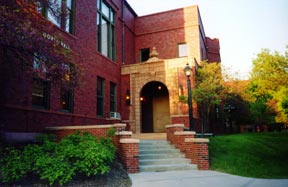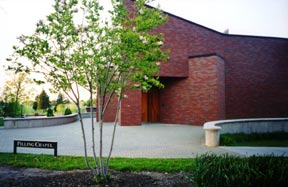Leighty-Tabor
Science Center
•
 Since
its opening this spring, the Leighty-Tabor Science Center
can only be described as the most criticized new building
in recent memory, and indeed it’s path to fruition
has been plagued with problems and suspicion. Months before
it opened, rumors circulated among the students that budget
cuts in the university would prohibit it from being furnished,
which could be viewed as something of a matter of importance. Since
its opening this spring, the Leighty-Tabor Science Center
can only be described as the most criticized new building
in recent memory, and indeed it’s path to fruition
has been plagued with problems and suspicion. Months before
it opened, rumors circulated among the students that budget
cuts in the university would prohibit it from being furnished,
which could be viewed as something of a matter of importance.
It
was also built on the parking lot in front of the fine arts
center, diminishing the size of an already tiny lot. Upon
its use, science faculty complained of air pressure and
room temperature and all those good factors of atmosphere
about which scientists like to complain.
I
myself had no personal opinions about the center until my
brother, a former Millikin student, visited a few days ago
and wanted to see the new building. We went to the roof
of the building, to a place called the observatory, and
we stood in silence as we looked over the campus that was
such personal part of each of our lives, a part which will
always bond us together.
the
observatory
with every step on the roof tile
siblings talk of mutual friends
the
coffee shop
•
If
the increasingly worn, irregularly tall seats surrounding
the two-person tables in the coffee shop could talk, they
certainly would have a number of stories to tell of awkward
first dates among Millikin students.
One
can only imagine how much water damage the cushions on those
chairs have incurred from the sweaty palms of hopeful lovebirds.
Though lacking the rustic charm of an older establishment
or the mystique of a modern, chain-smoking philosopher-filled
café, the coffee shop is Millikin’s closest
thing to a campus mixing grounds, and students have adjusted
to using it as their classy-yet-casual first date stopping
point.
Situated
across the street from the block of Millikin that encompasses
the academic buildings, the coffee shop maintains a feeling
of isolation from the daily grind of classes, and thus has
a more carefree and perhaps honest vibe than any other campus
locale.
after
his reply
to her question
only the creak of the table
Perkinson
Music Building
•
In
small, out-of-the-way office on the third floor of the music
building, she sits in her break between theory classes with
the sheet music for a new oboe serenade in one hand and
a student’s first attempt at composition in the other.
Her
walls are cluttered with framed pictures of her and her
husband (a vocal jazz specialist), drawings from her children,
and a somewhat hidden letter from the director of the Moscow
Symphony Orchestra proclaiming her excellence as oboist.
On the piano across from her desk lie several half-made
reeds, waiting to be the ones chosen to rest in her mouth
during breaks in rehearsal. In the midst of her forties,
her still-blond hair gives her a youthful and enthusiastic
appearance that matches her buoyant and refreshingly optimistic
personality. This demeanor lends her a genuine and deep
interest in her students, which pulls many of them through
the difficult subject that is music theory.
cornerstone
my teacher’s tears
as I thanked her

Staley
Library
•
Her
glasses have a way of making her eyes seem larger than possible,
and indeed it feels like she must have some special secret
to seeing all the activity in the Staley library at all
times. She sits behind the big front desk at the library,
engrossed in the computer screen where she is most likely
reading the names of delinquent students with overdue books.
I’ve never learned her name, and she probably doesn’t
know mine, but we’ve certainly developed a relationship
over my years in school.
On
more than one occasion, she has heard me talking to my friends
from all the way back in the stacks of scholarly journals.
Even when I sit behind the large staircase and am completely
out of her view, she still manages to recognize my whispers
with my colleagues. She has reminded me of the fact that
I am in a library so many times that I often believe I am
in a library when I truly am not.
However,
she has a keen sense of when I am in the library at the
eleventh hour, desperately trying to finish a project. Despite
my status as a chatterbox, she always assists me in a calm
and kind manner, as though she has never had to quiet me
at all.
after
closing the library
she shushes
the microfiche machine
Gorin
Hall
•
 Though
it serves as our admissions building, Gorin Hall is perhaps
the least welcoming of all of our campus haunts. Though
it serves as our admissions building, Gorin Hall is perhaps
the least welcoming of all of our campus haunts.
First
of all, it has an accessibility ramp for the disabled that
is so winding, I can only assume it makes the wheelchair-bound
person feel like a rat trapped in an elaborate scientific
maze.
It
also includes a large, marble, descending staircase that
leads to financial aid and quite literally feels like a
descent into the netherworld, which, for many students,
it probably psychologically is.
However,
it seems somehow to fit the expectations of prospective
students. The building provides the austere impetus that
makes the nervous students truly believe it would be an
honor for this school even to flirt with their acceptance.
Having
worked in the admissions office my entire sophomore year,
I have seen many a prospective student go through the scholarship
interview process and leave with a look that is only otherwise
found on a person who has just received a large dose of
morphine. But the most humorous of all are the parents of
these students, who mask their fear and anxiety in either
obnoxious overconfidence or a feigned interest in the lives
of admissions counselors at the school.
following
the interview
her parents
give her another
Shilling
Hall
•
As
the all-encompassing academic building and also the most
student-frequented spot on campus, Shilling Hall holds the
unique position of both social mecca and serious place of
scholarship.
Lining
the walls of the building are subdued posters for speakers
on issues of labor abuse in Africa juxtaposed with loud
neon signs advertising the coffee shop debut of the latest
campus rock band. This odd dual role often leads to conversations
that seem humorous and out of place within the building,
like the boy I once overheard discussing the sexual activities
of himself and his girlfriend outside a class in which feminist
writers were the focus of the lecture. It is an odd, but
somehow familiar balance, that almost begs students to fuse
social and academic lives.
the
test on issues in poverty finished
she meets her friend
to give her beer money
Richards
Treat University Center
•
The
Richards Treat University Center (RTUC) always reminds me
of freshmen orientation and training as an orientation leader.
Its three multipurpose rooms in the lower level are used
to house the first social mixer for the freshmen in the
fall, and coincidentally are the location for all of the
major meetings between orientation leaders themselves. During
these meetings, I have traced the outline on the ugly, yellow-orange
carpet so many times I could never count.
However,
these rooms have also housed some of the most exciting moments
of my life. It is on those floors that I went to a formal
dance with my two closest friends and cemented our best
friendships. It is also on these floors that I have witnessed
major emotional moments, including students asking others
out on dates, professors expressing their best wishes at
the annual Christmas cookie party, and even friends getting
involved in accidents (an acquaintance once sprained his
ankle in this room). Thus, RTUC is eclectic in its purpose
and in the scenes it witnesses.
night
before freshmen arrive
two soon-to-be role models
wrestle on the ground
Pilling
Chapel
•
 One
of the newest buildings on campus, Pilling Chapel is the
home of religious services, some fraternity and sorority
meetings, and the occasional musical performance. It is
a multipurpose building whose name lends sobriety to whatever
event is held within its walls. One
of the newest buildings on campus, Pilling Chapel is the
home of religious services, some fraternity and sorority
meetings, and the occasional musical performance. It is
a multipurpose building whose name lends sobriety to whatever
event is held within its walls.
Since
the beginning of my career here, I have attended weekly
catholic mass at the chapel. Interestingly, the chapel is
not really designed for many of the parts of religious service
itself. Its seats contain no kneelers on which attendees
can get down on their knees during the appropriate sections
of the mass.
However,
I have noted that one girl continually kneels, despite the
physical arrangement of the church and the protestations
of the priest against the necessity of kneeling. I continually
marvel at her shut-eyed prayer and look of determination,
as she does her best to look more devout than the rest of
the students around her.
while
everyone else sits
the kneeling girl
shows off her humility
|